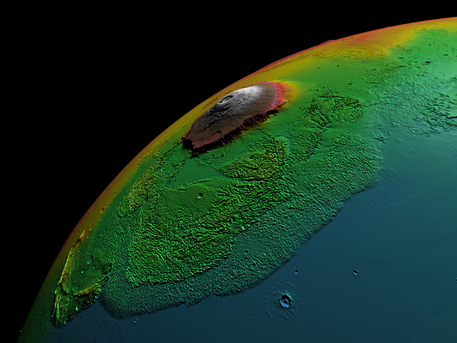IYA Question of the Week
What is the highest mountain in our solar system?
The Olympus Mons (Latin for Mount Olympus) rises 85,000 feet above the Martian surface. This makes it the highest and, with its diameter of 370 miles, also the largest known mountain. As a giant volcano, it spewed molten rock from deep within the Red Planet for billions of years. Scientists suspect that it is still active today.
 © NASA
|
Only the so-called false-color image shows how high the Olympus Mons rises above the Martian surface. The uniform rock color on Mars would make it impossible for us to appreciate the size of the mountain in true colors.
The Olympus Mons is three times higher than Mount Everest, the highest mountain on Earth. At first thought, it therefore seems surprising that Mars is considerably smaller than the Earth. It is only about half the diameter of the Earth, and its mass is only about one tenth of that of the Earth.
Despite its relatively small size, Mars has the mightiest mountains.
In fact, it is precisely because of Mars’s relatively small size that its mountains can grow so tall. Due to its significantly smaller mass, the gravity or attraction of Mars is much smaller than that of the Earth. For this same reason, astronauts can jump so far on the Moon - gravity is lower there, which means that the astronauts weigh much less than they would do on Earth.
In this same way, a volcanic mountain piling layers of lava one on top of the next weighs less on Mars than an equally tall mountain would on Earth. The rock masses of a Martian mountain therefore also exert less pressure on the layers on which they rest. And as long as the planet's mantle can still support the weight of the mountain, it can continue to grow taller. Mountains on planets with a relatively small mass can thus rise higher than mountains on larger planets.
Credit: German Aerospace Center
Despite its relatively small size, Mars has the mightiest mountains.
In fact, it is precisely because of Mars’s relatively small size that its mountains can grow so tall. Due to its significantly smaller mass, the gravity or attraction of Mars is much smaller than that of the Earth. For this same reason, astronauts can jump so far on the Moon - gravity is lower there, which means that the astronauts weigh much less than they would do on Earth.
In this same way, a volcanic mountain piling layers of lava one on top of the next weighs less on Mars than an equally tall mountain would on Earth. The rock masses of a Martian mountain therefore also exert less pressure on the layers on which they rest. And as long as the planet's mantle can still support the weight of the mountain, it can continue to grow taller. Mountains on planets with a relatively small mass can thus rise higher than mountains on larger planets.
Credit: German Aerospace Center

